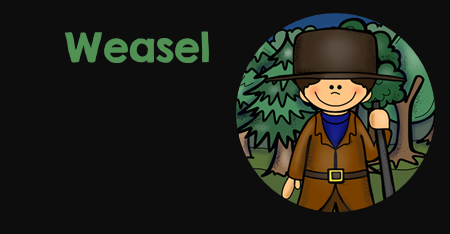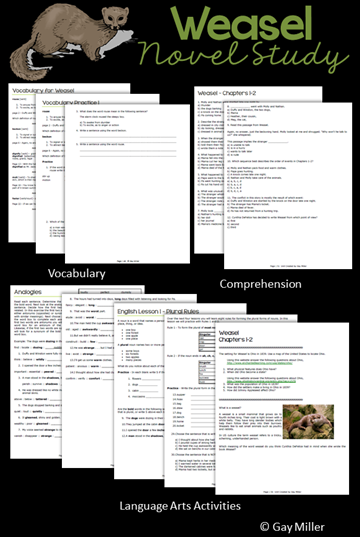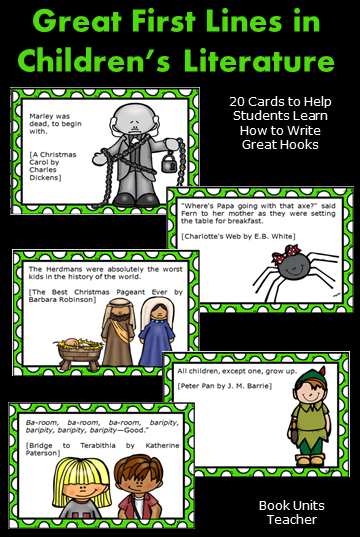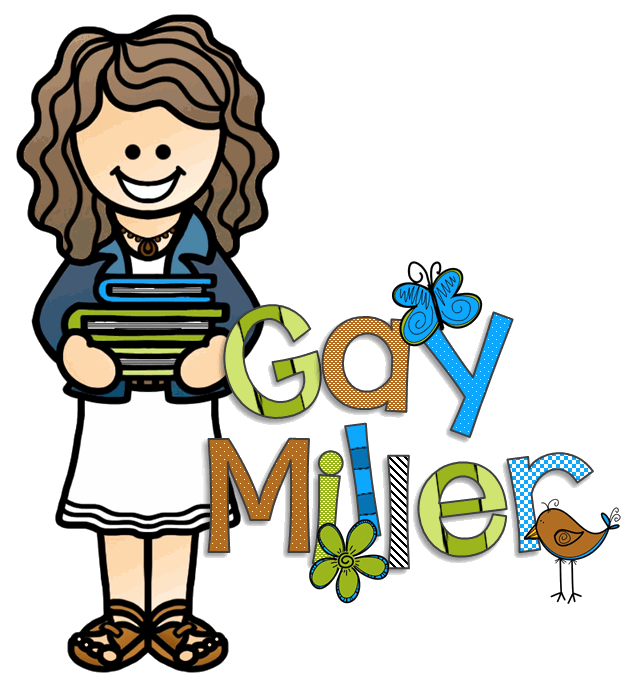
Weasel by Cynthia DeFelice is a historical fiction novel.
After the Removal Act of 1830, the U.S. government hires a man, known as Weasel, to remove the Shawnees from the Ohio Territory. Once all the Native Americans have fled, Weasel stays in Ohio. He then turns on the white settlers.
One of Weasel’s victims is eleven-year-old Nathan’s pa. Nathan struggles between taking the law into his own hands and letting Weasel go,
Read Weasel to see if Nathan seeks revenge or is able to let bygones be bygones.
Weasel Activities
Book Unit Samples

You will find the following in this novel study sample:
- Vocabulary Practice for Chapters 1-2
- Comprehension Questions for Chapters 1-2
Teaching Idea #1 – Great First Lines in Children’s Literature

Weasel has a great opening line:
The dogs were dozing in their usual places by the fire when the knock came.
This free set of cards contains 20 cards with great opening lines from children’s literature. Have students sort the cards by type:
- dialogue
- question
- vivid description
- interesting fact
- sound effect
Teaching Idea #2 – Bringing Ezra Back by Cynthia DeFelice
Cynthia DeFelice reads from Bringing Ezra Back, the sequel of Weasel. The sequel takes place five months after the book Weasel ends. In the next book, Nathan sees a handbill advertising a show with a ‘white injun.’ Nathan plans to save Ezra from being an exhibit in the traveling show. He sets out from Ohio to Pennsylvania with Orrin Beckwith, a peddler. Along the way, Nathan encounters others who are both helpful and mean.
Teaching Idea #3 – Comparing Book Covers


Compare book covers for the book Weasel. Have students select the cover that best represents the story. Ask guiding questions such as:
How did the illustrators portray Weasel on the two covers?
What is the main focus of each book cover?
Which cover do you think best represents the content of the book? Why?
What emotions or feelings do the different covers evoke in you? Which cover do you think is the most effective in this regard?
How do the different covers use color, images, and text to convey their messages? Which cover do you think is the most visually appealing? Which cover makes the reader want to read the novel? Explain why.
What similarities do you notice among the different covers for Weasel? What differences stand out to you?
If you were designing a new cover for Weasel, what elements would you include? Why?
How does the cover of a book influence your decision to read it? Would any of these covers make you more or less likely to pick up Weasel? Why?
Do you think the covers accurately portray the themes and content of the book? Why or why not?
How do the different covers appeal to different audiences? Which cover do you think would be most appealing to middle-grade readers? To adults?
Teaching Idea #4 – Discussion Questions

- What did you think of the book’s ending?
- How did Nathan change over the course of the book?
- What role did Weasel play in Nathan’s life?
- Do you think Nathan made the right decision in the end? Why or why not?
- What are some themes or messages that you took away from the book?
You will find sample answers on editable Google Slides.
See the product that inspired this post.

Weasel Novel Study includes vocabulary practice, comprehension questions, constructed response writing, and skill practice.


